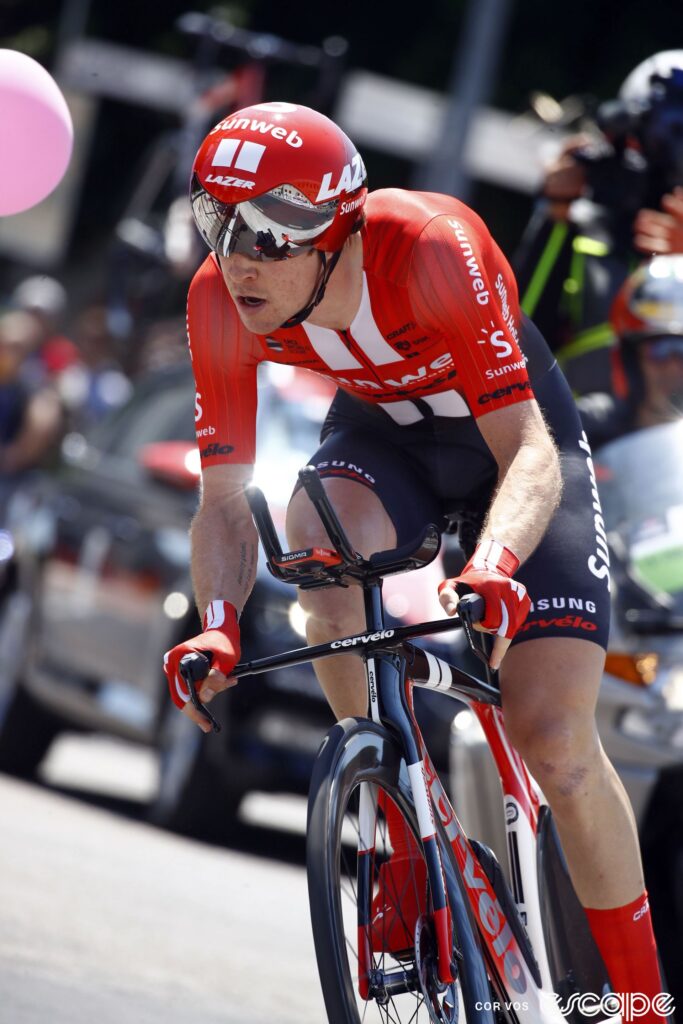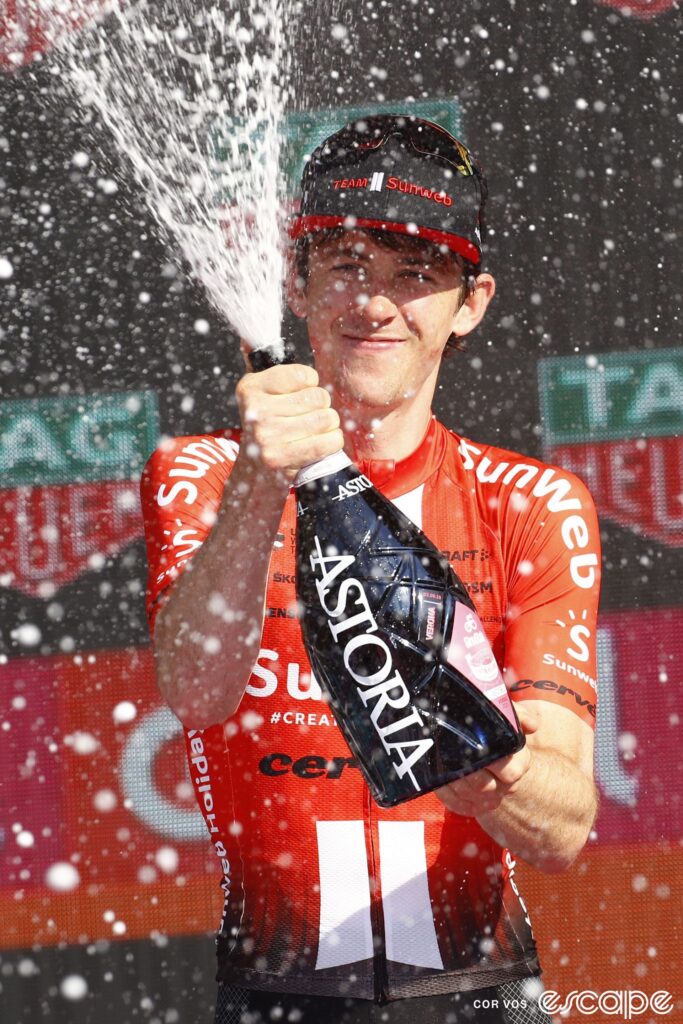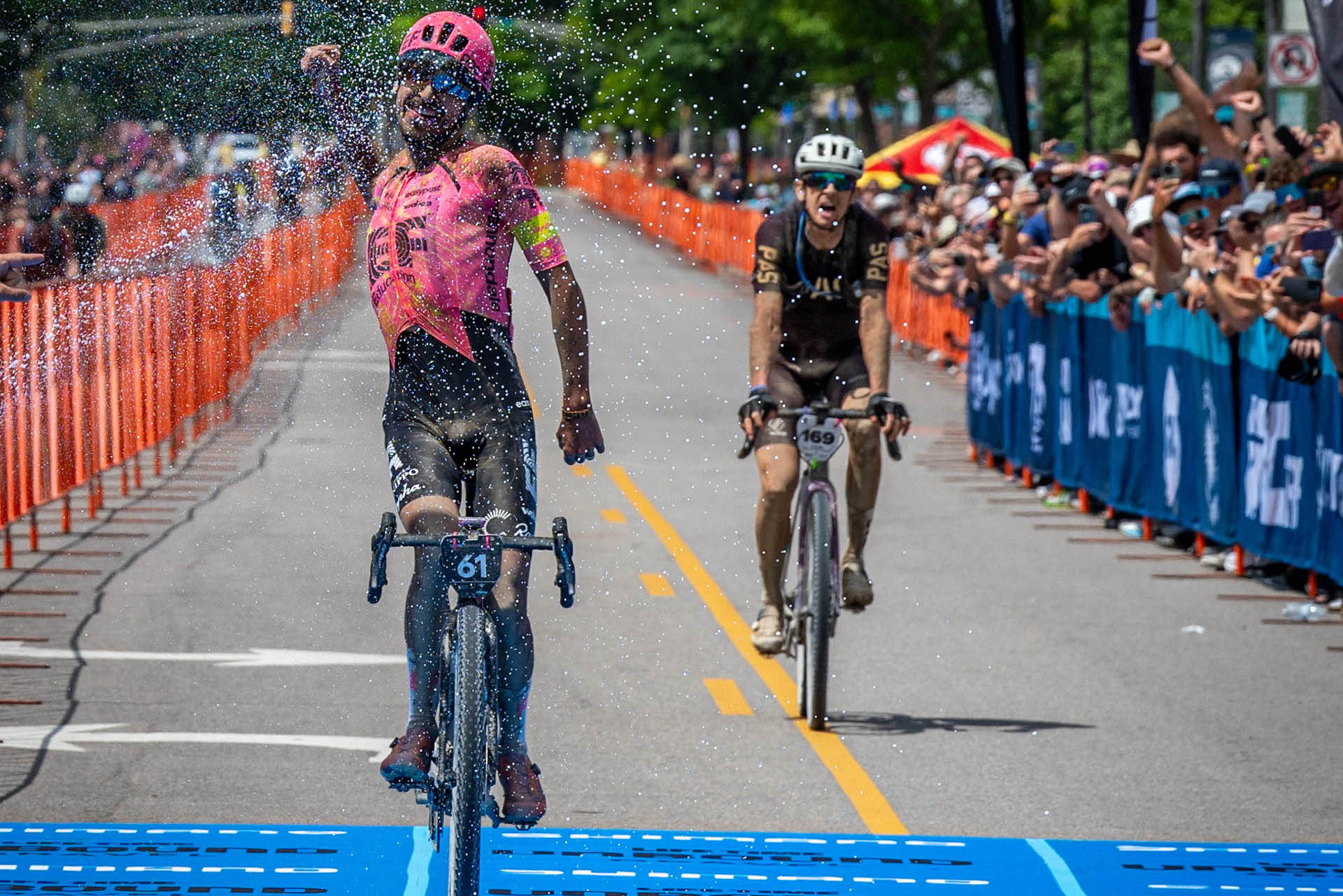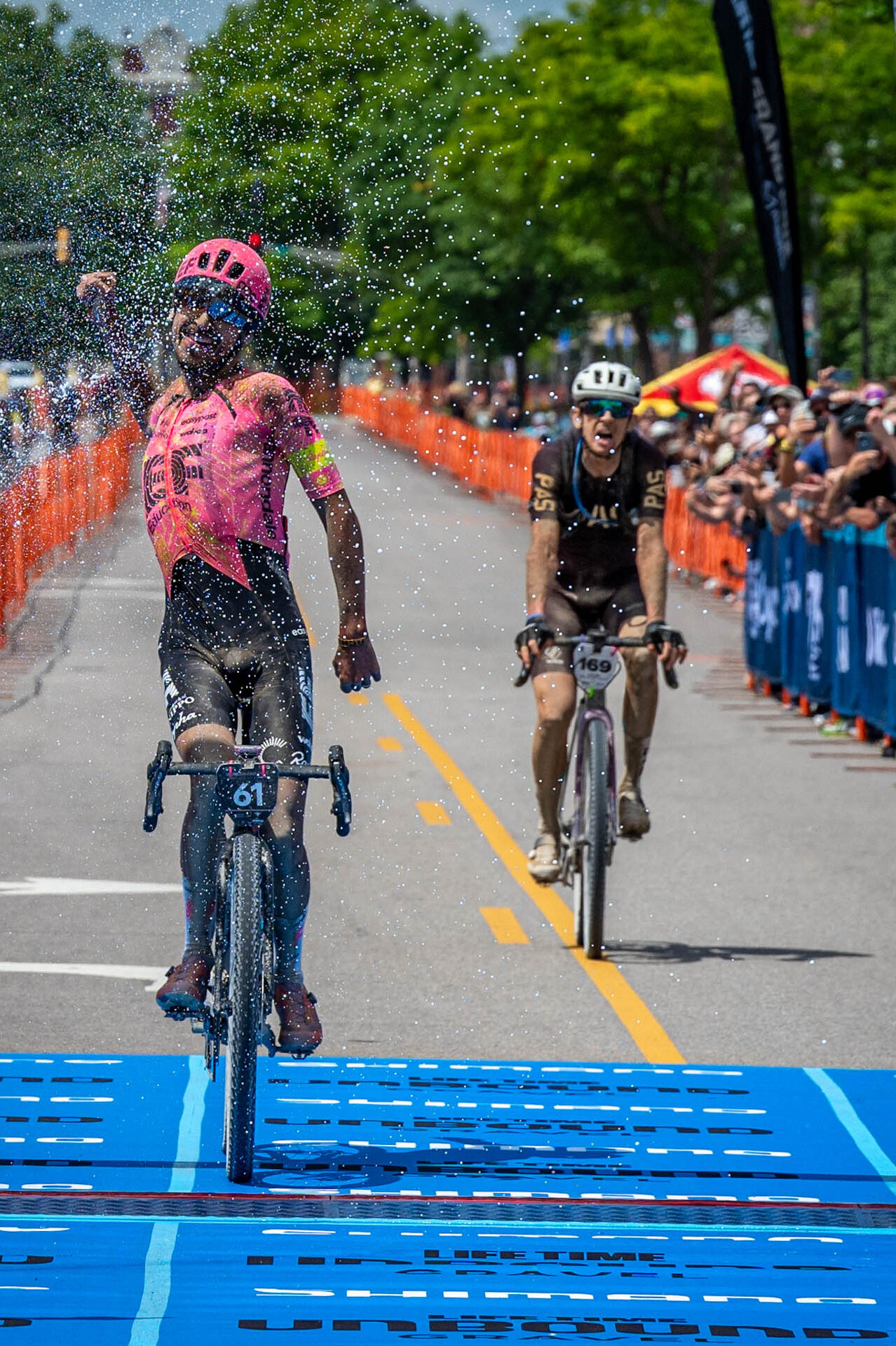Chad Haga was a stalwart in the WorldTour for nearly a decade, cutting his teeth as a core member of Team Sunweb in support of leaders like Tom Dumoulin during the Dutchman’s win in the 2017 Giro d’Italia and various Tour de France campaigns. Haga even claimed a Grand Tour stage victory for himself in the final time trial of the 2019 Giro.
Haga signed off on his road career, which he finished with Human Powered Health, when he broke his wrist last August and the men’s team shuttered at the end of the season. Nevertheless, Haga wasn’t ready to hang up his wheels just yet and launched into a campaign to enter the gravel scene as a privateer.
In a fashion reminiscent of his unorthodox path into pro cycling after completing his education at Texas A&M, Haga went his own way to secure support for the year by establishing a new Fastest Known Time last October on the 360 km route of the Traka, the biggest event on the European gravel calendar.
That was enough for Haga to build a portfolio of sponsors (both individual and through his association with the Pas Racing collective) to support his effort to stay at his comfortable home base in Girona and race a full season of gravel. While it was a bit of a curveball for Haga to stay in Europe to race within a discipline where the top events are in America, it was all a part of a plan to prioritize time with his family and still dip a toe into a new endeavor in the sport he loves.
Nevertheless, Haga was able to plan one trip to the US to race Unbound Gravel and it paid dividends with the American finishing a close second in the world’s biggest gravel race. Pair that with a podium at the Traka this May, and just partway through his rookie season Haga is now firmly established as a big name in gravel racing.
To get a sense of his Unbound success and his plans as a privateer, we caught up with Haga during his one day in his old hometown of Fort Collins, Colorado the Monday after Unbound.
The following conversation has been lightly edited for clarity.
Logan Jones-Wilkins: It seems like the individuality of gravel cycling allows for people’s personalities to come through from their riding styles. What do you think your ride at unbound says about yourself as a person or as a rider?
Chad Haga: For me, the ride was about my patience and calculation. Not so much planning at Unbound, but just reading the race and finding the right moment to strike. I don’t know how to summarize it in a word, but I was proud of the way that I approached the ride, like in a technical section backing off the wheel a bit, leaving a small gap, and burning a little bit more energy so that you have that fraction of a second to see the rock. It’s worth it to me to burn a little energy and keep air in my tires rather than stay on the wheel and risk a flat.
Other guys weren’t willing to take that risk, and a lot of guys flatted. I can’t say that was the only reason why I didn’t flat, but I believe what helped me was a little bit of wasted energy in pursuit of clean lines. I was not in the big fight before some sections early on, because there was so much glue in the field to pull it all back together. These are risks tactically, but it’s all calculations and playing the long game, knowing that most guys, after six or seven hours, are going to fade pretty hard. I’d say that suits my personality. I’m patient, I plan, I think ahead, I run through different scenarios, and I try to be ready for when the door opens.
LJW: Does that extend to before the race? It seems like you are well suited both through your WorldTour career and your college career as a mechanical engineer for that aspect of the challenge.
CH: Unbound was special because I didn’t know the course. I’d never done the race, so I was coming in with a real ignorance of what lay in front of me, so I couldn’t give it as much forethought as a lot of guys. They had some really exceptional bike setups, while I ran a very standard, uninteresting setup, but one that I knew worked for me. I knew how my tires rode, and how they performed – I knew everything about my setup and how it worked for me. And so in that way, it was very thought-through. But I’m also not a radical guy willing to try off-the-wall stuff. I’m very boring in that sense, traditional. I know what works for me, and I am pretty true to that.
The Traka was also different because I live there, yeah. So I knew that course intimately, and so I knew exactly what setup works well for it, and how to ride it and that sort of thing. So the way that I prepared for the two races was very, very different.

LJW: When you look at gravel in the context of your history as a road racer, how much of a new venture does it feel like, and how much of an iteration or a variation of what you did in the WorldTour?
CH: The way the racing plays out is very different. Like, it’s a peloton full of individuals and that is very different. Every individual is going to perform differently based on the setups that they choose to use. I see a guy on skinny slicks and it’s like, “Okay, he’s gonna lose the wheel in the corner, but he’s gonna be faster on the straightaway.” When you see a guy running knobby tires with a mountain bike background it’s like, “All right, watch out for him on the descent.” So that sort of tactic factors in.
As far as the habits that I developed in road racing, it’s also different. I didn’t have to give any thought to the day of the race. I know my rhythm before the race, all of that is so automated at this point that I didn’t even have to think about it. But around gravel racing, there’s so much more to think about than I ever had to as a road racer, starting with the logistical side of it. There’s so much more planning and coming over here for a trip like “What tires do I think I might need?” and packing all of that and doing the nutrition calculations, how much sugar I need to travel with.
There are just so many more elements to stay on top of and to plan for. So that has been a big learning experience, and I’m still adjusting to making all of that automated so that it doesn’t take so much active thought. I want it to come naturally in the same way that the road race morning routine does now.
LJW: In the ecosystem of North American gravel training, there is this huge attention to volume. Across the board, volume is king, especially the build-up to Unbound. You came in with a very different approach in terms of training 18-20 hours instead of 35-40 hours that others are doing. What was behind that?
CH: I know from history that if my fitness reaches a certain level, I can just motor for nine to 12 hours. It certainly helps to train with large volume, but I know that at a certain level, that’s just something I can do, so I don’t need to do a ton of huge volume. I did do some big volume earlier in the spring, before Traka, but nothing monster. And that’s also part of how I have to approach gravel racing. I have two kids, I have family commitments, and that is a hugely important part of my life.
I want to be the best gravel racer that I can be and I’m committed to that, but I’m going to do so with what’s left from family life. So I’ve been getting in as much training as I possibly can, given the constraints of my other obligations, and that equates to less volume than some of these guys.
LJW: When you’re a road rider, you raced for a team that was notorious for its systems in DSM. It seemed like you were able to adapt to an established structure, fit in, and do your job extremely well. Now you can continue as a gravel racer independently and you’re coming into a newer, less-defined sport. Are you excited about your position to be someone who might not be within a system, but now defining what could be a system for others to come?
CH: Defining the future of the sport doesn’t excite me so much, but I’m excited by the fact that my role, as in road racing, has prepared me so well for this other side of cycling that I enjoy so much. Being a diesel in support of a GC rider is very similar to the sort of physical effort that a gravel race demands, just kind of always being on the pedals. You never have a super easy day.


LJW: The time trial aspect of it too, being someone who looks at things like aerodynamics and tire rolling resistance is not too far afield from the demands of gravel racing.
CH: In that sense, yes, it’s also speaking of time trialling, especially on a dangerous course like Unbound, where at any moment, a rock can just deflate your hopes for the day. Being a rider who can sense their power output naturally and not need to look at a power meter is valuable. I know how hard I need to go and what I can hold. I don’t need a power meter to tell me what is going on. I use that data, but if I needed to look at my screen to tell me how hard to go, my chances of hitting a rock go up. In that sense, being a time triallist by feel is a skill that translates well.
LJW: That must have put you in a really good headspace when you found yourself off the front with Lachlan Morton, because you both, in different ways, intuitively knew exactly what pace works at that point in the race since he was riding without power data.
CH: We said so few words to each other, and we both immediately fell into the exact same pace. There was no, “Oh, I think we should go a little bit harder, a little bit slower,” we had the exact same pace. We were both on flying days, we had no energy shortage, we just immediately fell into a rhythm with each other. That was like, “Yes, this is the pace we need to hold, and we both can do it. And let’s go.”
LJW: It’s interesting to consider riders like yourself, Lachlan, and Greg Van Avermaet. You’re similar ages, you’ve had long careers, but you couldn’t really pick any three more different ex-WorldTour riders. If you could draw a through-line between the three of you guys, the three ex-WorldTour riders who were in the top 10 this year, what could you see as similarities?
CH: We all have wisdom that comes with age and we’ve got just an entire career archive of fitness that provides confidence. Once you do Grand Tours and long races you know that once you reach a certain level of fatigue, you’re like, hitting the floor. Once you get there, things don’t drop much.
Also, with it being largely an individual sport, you don’t have to worry so much about the team dynamics, like, “Oh, he’s got teammates, and I don’t.” Everybody’s kind of in this together so you can kind of always find somebody to work with you.
LJW: Through the racing you have described, Unbound seems enthralling. It seems to contain what fans of the sport value in the Classic or long, drawn-out Grand Tour stage battles. The problem is we don’t get to see it the same way that we get to see Jumbo-Visma attacking Tadej Pogačar in the 2022 Tour de France. How can we as the media or you as a rider communicate that and extend that intrigue to people who might enjoy it if they understood those intricacies in the same way we understand the minutiae of road cycling?
CH: As the live feeds and that sort of thing increases, it helps. There’s just so much that happens that if you can’t see it, it’s hard to even understand what’s happening. On my travel day tomorrow, I intend to write my race report of how those nine hours and 11 minutes played out, and hopefully, people can see a bit more, because I’m realizing, as I talk to friends and family, the live feed largely missed the last mile of the race. I could almost write a book about what happened in those final few minutes. It was a wild, wild few minutes and a lot of that went unnoticed.
LJW: Yes, the comments on the live Instagram feed were all curious about what happened in that last mile, and included comments from the likes of Matteo Jorgensen, Riley Sheehan, Chris Blevins, and so many other big European-based cyclists. So, it’s not just your friends and family, it’s people who seem to have a true curiosity around Unbound.
CH: A lot of those guys are former colleagues and friends, and they know that it’s the biggest gravel event, so of course they want to know what happened. The fact that it’s the biggest gravel event seems to genuinely mean something to people. It’s curious how it became the biggest gravel event, but yeah, the fact is a lot of people care.
LJW: Do you think you understand more of why that is now that you have done it?
CH: It’s just grassroots racing grown up. It started as a grassroots event, just kind of this crazy idea of “What if you did 200 miles in Flint Hills of Kansas?” Everybody loves a challenge, and it’s just achievable enough for most people. The fact that this year the elites had their own start time meant we didn’t interact with the rest of the riders, but for a long time, it was just everybody starting together. All of that just made the performances more real.
Like, if you do the same course, at the same time, and see just how much faster we go, it makes it more real to them, and then they can better understand their performance. Because, you watch the Tour go up the Tourmalet or something, and you don’t fully grasp just how fast they’re going uphill until you can experience that yourself. But it’s just over the years grown and grown and given a long enough timeline, you get to where we are now, which is incredible viewership, participation, and importance to the industry.
What did you think of this story?


